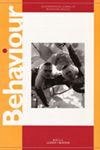Effects of snow leopards (Panthera uncia) on olfactory communication of Pallas’s cats (Otocolobus manul) in the Altai Mountains, Mongolia
IF 1
4区 生物学
Q4 BEHAVIORAL SCIENCES
引用次数: 0
Abstract
Olfactory communication is important for many solitary carnivores to delineate territories and communicate with potential mates and competitors. Pallas’s cats (Otocolobus manul) are small felids with little published research on their ecology and behaviour, including if they avoid or change behaviours due to dominant carnivores. We studied their olfactory communication and visitation at scent-marking sites using camera traps in two study areas in Mongolia. We documented four types of olfactory communication behaviours, and olfaction (sniffing) was the most frequent. Pallas’s cats used olfactory communication most frequently at sites that were not visited by snow leopards (Panthera uncia) and when they used communal scent-marking sites, they were more likely to use olfactory communication when a longer time had elapsed since the last visit by a snow leopard. This suggests that Pallas’s cats may reduce advertising their presence in response to occurrence of snow leopards, possibly to limit predation risk.蒙古阿尔泰山雪豹(Panthera uncia)对大猫(Otocolobus manual)嗅觉交流的影响
嗅觉交流对许多独居的食肉动物来说很重要,它可以划定领地,与潜在的配偶和竞争对手交流。帕拉斯猫(耳疣猫手册)是一种小型猫科动物,很少有关于它们的生态学和行为的发表研究,包括它们是否会因为食肉动物的优势而避免或改变行为。我们在蒙古的两个研究区使用相机陷阱研究了它们在气味标记点的嗅觉交流和访问。我们记录了四种类型的嗅觉交流行为,嗅觉(嗅)是最常见的。帕拉斯的猫在没有雪豹(Panthera uncia)去过的地方最频繁地使用嗅觉交流,当它们使用公共气味标记地点时,当雪豹最后一次访问的时间过去较长时,它们更有可能使用嗅觉交流。这表明帕拉斯的猫可能会减少宣传自己的存在,以应对雪豹的出现,可能是为了限制捕食的风险。
本文章由计算机程序翻译,如有差异,请以英文原文为准。
求助全文
约1分钟内获得全文
求助全文
来源期刊

Behaviour
生物-动物学
CiteScore
1.80
自引率
7.70%
发文量
44
审稿时长
3 months
期刊介绍:
Behaviour is interested in all aspects of animal (including human) behaviour, from ecology and physiology to learning, cognition, and neuroscience. Evolutionary approaches, which concern themselves with the advantages of behaviour or capacities for the organism and its reproduction, receive much attention both at a theoretical level and as it relates to specific behavior.
 求助内容:
求助内容: 应助结果提醒方式:
应助结果提醒方式:


